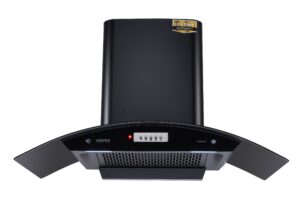
The Comprehensive Guide to Kitchen Chimneys in Asansol: Enhancing Your Cooking Experience
Introduction In the bustling industrial city of Asansol, known for its dynamic urban life and rich cultural heritage, the modern kitchen is becoming increasingly sophisticated. Among the essential appliances transforming kitchen spaces, the kitchen chimney is a key player. It plays a pivotal role in maintaining a clean, fresh, and comfortable cooking environment, which is crucial given the local climate and cooking styles. This guide explores the significance of kitchen chimneys, their benefits, types, installation processes, and maintenance tips, specifically tailored for Asansol. Why a Kitchen Chimney is Essential 1. Improved Air Quality Asansol, with its mix of industrial and residential areas, can sometimes face issues with air quality, particularly in densely populated neighborhoods. In such an environment, a kitchen chimney becomes indispensable. It efficiently captures and expels smoke, grease, and strong odors, ensuring that your kitchen air remains clean. This is especially crucial in a city where outdoor air quality might not always be optimal. 2. Enhanced Kitchen Hygiene The local cuisine in Asansol, which includes a variety of spicy and flavorful dishes, often involves extensive use of oil and spices. This can lead to significant grease and oil splatter in the kitchen. A kitchen chimney helps in preventing the buildup of these substances on kitchen surfaces, walls, and cabinets. By maintaining a cleaner kitchen environment, you not only improve hygiene but also enhance the longevity and appearance of your kitchen fixtures. 3. Reduced Heat and Smoke Cooking generates a considerable amount of heat and smoke, which can make the kitchen uncomfortable, particularly during Asansol’s hot and humid weather. A kitchen chimney extracts these elements, keeping your kitchen cooler and more pleasant. This feature is particularly beneficial during peak cooking times, such as during family meals or special occasions. 4. Prevention of Health Issues Regular exposure to smoke and cooking fumes can lead to respiratory problems and other health concerns. A kitchen chimney helps mitigate these risks by effectively removing harmful particles and ensuring better air quality. This is particularly important for households where members might have respiratory conditions or allergies. Types of Kitchen Chimneys Selecting the right type of kitchen chimney can significantly impact its effectiveness and suitability for your kitchen. Here’s an in-depth look at the most common types: 1. Wall-Mounted Chimneys Wall-mounted chimneys are installed on the wall above the cooking area. They are ideal for traditional and contemporary kitchen designs and come in various sizes and styles. In Asansol, where kitchen layouts can vary from compact to spacious, this type of chimney is versatile and effective. Design Flexibility: These chimneys are available in various styles, from modern to classic, allowing you to choose one that fits your kitchen’s aesthetic. Installation Considerations: Ensure that the chimney is installed at an optimal height above the cooking area for effective performance. 2. Island Chimneys For kitchens with a central cooking island, island chimneys are the perfect choice. Mounted on the ceiling above the cooking island, they offer a sleek, modern look and are particularly effective in open-plan kitchens, which are becoming increasingly popular in Asansol’s modern homes. Aesthetic Appeal: Island chimneys provide a stylish, contemporary appearance and can serve as a centerpiece in your kitchen. Installation: Proper ceiling mounting and ducting connection are crucial for optimal performance. 3. Built-In Chimneys Built-in chimneys are integrated into kitchen cabinetry, providing a seamless and stylish appearance. This type is ideal for minimalist and modern kitchens in Asansol, where a clutter-free look is desired. Space Efficiency: Built-in chimneys blend with cabinetry, saving space and creating a streamlined look. Customization: These chimneys can be customized to fit specific cabinet sizes and kitchen layouts. 4. Under-Cabinet Chimneys Installed beneath the kitchen cabinets, under-cabinet chimneys are a space-efficient option for smaller kitchens. They offer practical ventilation without occupying additional space, making them a suitable choice for many homes in Asansol. Convenience: Ideal for compact kitchens or where space is at a premium. Maintenance: Ensure that filters are easy to remove and clean for convenience. 5. Corner Chimneys Corner chimneys are designed for kitchens with corner cooking areas. They are mounted in the corner and effectively capture smoke and fumes from all angles, making them a practical choice for unique kitchen layouts. Effective Ventilation: Ensures that smoke is efficiently captured from the corner cooking area. Design Considerations: Choose a model that fits the corner space and complements the kitchen’s overall design. Key Features to Consider When selecting a kitchen chimney, several features are crucial for ensuring that it meets your needs and performs efficiently: 1. Suction Power Suction power, measured in cubic meters per hour (m³/h), determines how effectively a chimney removes smoke and odors. For Asansol, where cooking often involves rich, aromatic dishes, a chimney with higher suction power is essential. Cooking Style: Choose a chimney with higher suction power if you frequently prepare dishes that generate significant smoke and grease. Kitchen Size: Larger kitchens may require chimneys with higher suction capacities for optimal performance. 2. Filter Type The filters in a kitchen chimney play a significant role in capturing grease and other particles. Common types include: Baffle Filters: These are highly effective at trapping grease and are easy to clean. They are suitable for Indian cooking methods, which often involve frying and grilling. Charcoal Filters: Designed to absorb odors, charcoal filters are ideal for kitchens where strong smells are prevalent. Mesh Filters: Basic filters that capture larger particles. They may require more frequent cleaning and are often used in combination with other filter types. 3. Size and Design The chimney’s size should correspond to the size of your cooking area. Additionally, the design should complement your kitchen’s decor, whether you prefer a modern, sleek look or a more traditional style. Size Matching: Ensure that the chimney’s width matches or exceeds the width of your cooking range for effective ventilation. Design Harmony: Select a design that aligns with the overall aesthetic of your kitchen. 4. Noise Level Some kitchen chimneys can be noisy during operation, which can be disruptive. Choose a model with acceptable




